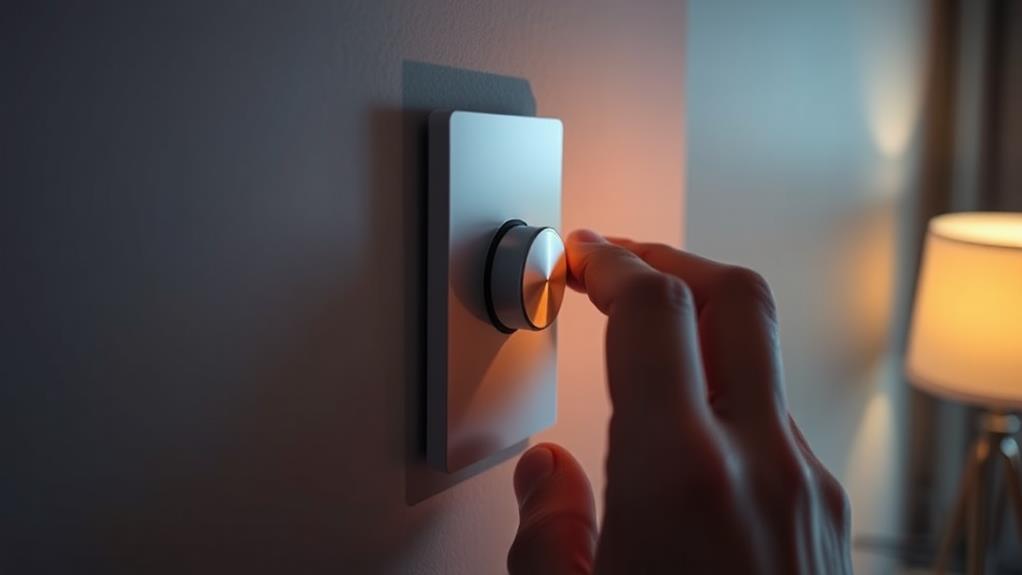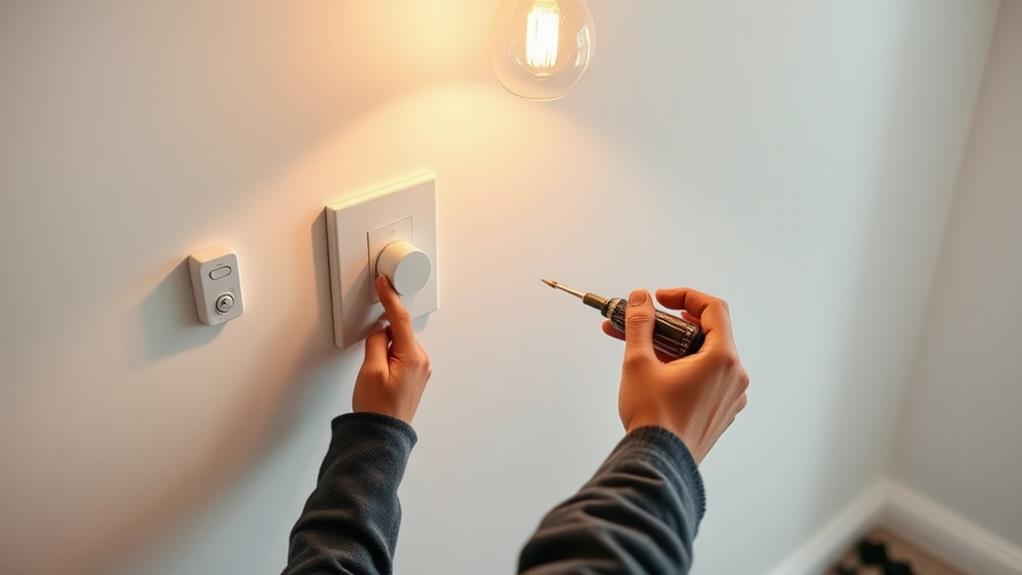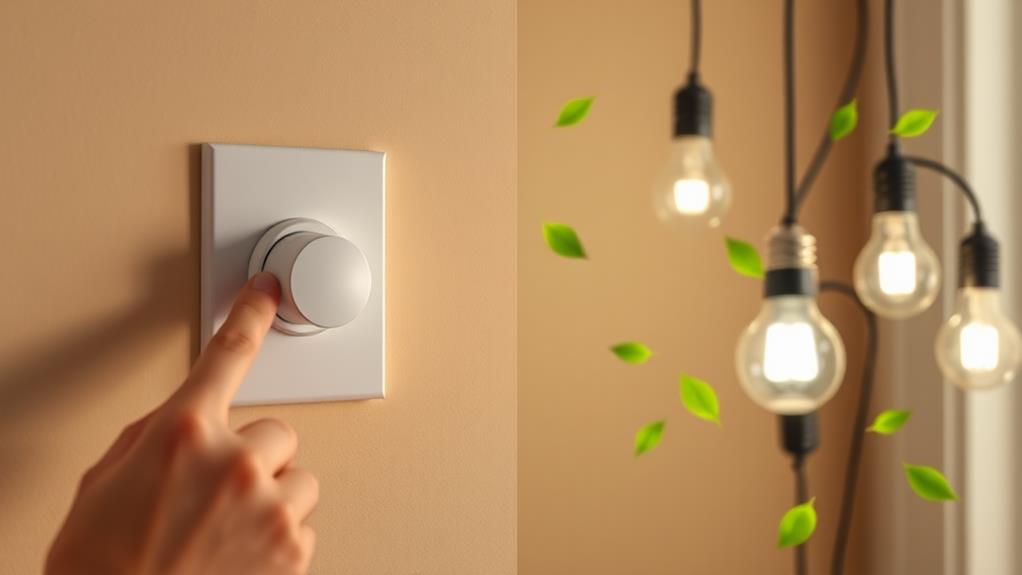Dimmer switches and motion sensors are easy-to-implement energy-saving devices for your home. Dimmers let you adjust light brightness, saving up to 40% on energy costs when dimmed by 50%. Motion sensors automatically control lighting, reducing usage in intermittently used areas by 35-45%. Both are simple to install and compatible with various bulb types. By combining these technologies, you can cut your lighting energy consumption by 20-30%. When choosing products, consider your existing fixtures, desired features, and installation preferences. With these smart devices, you'll not only save energy but also enhance your home's comfort and security. Discover how to maximize your savings potential with the right setup.
Understanding Dimmer Switch Technology

Dimmer switches revolutionize the way we control lighting in our homes and offices. These devices allow you to adjust the brightness of your lights, giving you more control over your environment and energy consumption. Modern dimmer switches use solid-state technology, typically employing either triac or transistor-based circuits to regulate power flow to the light fixture.
When you turn the dimmer knob or slide the switch, you're actually changing the amount of electricity that reaches the bulb. This is achieved by rapidly switching the power on and off, many times per second. The human eye can't detect this flickering, perceiving only a steady, dimmed light.
It's important to note that not all light bulbs are compatible with dimmers. Traditional incandescent and halogen bulbs work well, but you'll need specially designed dimmable LED or CFL bulbs for these newer technologies.
When choosing a dimmer switch, make sure it's rated for the type and wattage of bulbs you're using. By properly installing and using dimmer switches, you can create the perfect ambiance while reducing your energy bills and extending the life of your light bulbs.
Benefits of Motion Sensors
Motion sensors' primary benefit is their ability to conserve energy by automatically controlling lighting. They ensure lights are only on when needed, significantly reducing unnecessary energy consumption. You'll see immediate savings on your electricity bills, especially in areas where lights are often left on accidentally.
These devices also offer convenience. You won't need to fumble for switches in dark rooms or worry about turning lights off when leaving. This is particularly useful in spaces like garages, closets, or outdoor areas where you might've your hands full.
Motion sensors enhance security too. Intruders are deterred by sudden illumination, and you'll feel safer approaching your home at night with automatic lighting. They're also great for safety, illuminating potentially hazardous areas like stairs or uneven walkways.
You'll find motion sensors are versatile and can be integrated with other smart home systems. They can trigger not just lights but also alarms, cameras, or heating systems. This adaptability makes them a valuable component in creating an efficient, responsive home environment.
Lastly, motion sensors can extend the life of your light bulbs by reducing their overall usage time, leading to less frequent replacements and additional cost savings.
Installation and Setup Process

The installation and setup process for dimmer switches and motion sensors is typically straightforward, even for those with limited DIY experience. For dimmer switches, you'll first need to turn off the power at the circuit breaker. Remove the existing switch plate and switch, then connect the dimmer switch's wires to the corresponding house wires. Secure the dimmer in the electrical box and reattach the switch plate.
Motion sensors are equally simple to install. Most models are battery-operated and can be mounted using screws or adhesive strips. Place them in areas with high traffic or where lights are frequently left on. Some motion sensors can be integrated into existing light switches, requiring a similar installation process to dimmer switches.
After installation, you'll need to adjust the settings. For dimmers, this involves setting the minimum and maximum brightness levels. Motion sensors often have adjustable sensitivity and timer settings. You can customize these to suit your needs, such as increasing sensitivity in larger rooms or extending the timer in frequently used areas.
Remember to test your newly installed devices thoroughly to ensure they're functioning correctly and meeting your energy-saving goals.
Energy Savings Potential
With proper implementation, dimmer switches and motion sensors can lead to significant energy savings in your home. Dimmer switches allow you to adjust light levels, reducing energy consumption when full brightness isn't necessary. By dimming lights by 25%, you can save up to 20% on energy costs. Dimming by 50% can increase savings to 40%.
Motion sensors automatically turn lights off when rooms are unoccupied, eliminating wasted energy from forgotten lights. They're particularly effective in areas with intermittent use, like bathrooms, laundry rooms, and garages. You can expect to save 35-45% on lighting energy in these spaces.
Combining dimmer switches and motion sensors maximizes your energy-saving potential. For example, in a hallway, you can set the motion sensor to activate lights at 50% brightness, further reducing energy use. You'll see the most significant savings in rooms where lights are frequently left on unnecessarily.
To estimate your potential savings, consider your current lighting habits and energy rates. On average, households can reduce their lighting energy consumption by 20-30% with these devices. This translates to lower electricity bills and a reduced carbon footprint.
Choosing the Right Products

When it comes to selecting the right dimmer switches and motion sensors, you'll need to consider several factors. First, ensure compatibility with your existing lighting fixtures. LED and CFL bulbs often require specific dimmers, while incandescent and halogen bulbs work with most types. Check the wattage rating of your dimmer to match your light fixtures' total wattage.
For motion sensors, consider the sensor's range and detection angle. Indoor sensors typically cover smaller areas, while outdoor sensors need a wider range. Look for adjustable settings that allow you to customize sensitivity and duration. Some sensors offer additional features like daylight detection, which prevents activation during daylight hours.
Don't forget about installation requirements. Some products are designed for easy DIY installation, while others may require professional help. If you're renting, opt for plug-in options that don't require permanent modifications.
Lastly, consider smart home integration. Many modern dimmer switches and motion sensors can connect to your home's Wi-Fi network, allowing you to control them remotely or set schedules through smartphone apps. This added convenience can further enhance your energy-saving efforts and home automation capabilities.
Conclusion
You've embarked on a journey to illuminate your home's energy efficiency. Like a ship's captain adjusting the sails, you'll fine-tune your lighting with dimmers and motion sensors. These tools are your compass, guiding you through the seas of energy consumption. As you navigate this course, you'll discover hidden treasure in reduced bills and a lighter environmental footprint. Set sail with confidence, knowing you're steering towards a brighter, more sustainable future.

